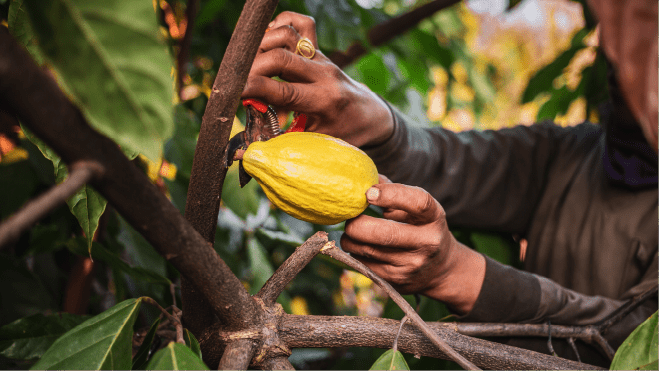How does the EU Deforestation Regulation (EUDR) affect my business?
End-to-end traceability in the food and beverage industry refers to the ability to follow the journey of food products from the farm to the consumer's plate. As consumers demand transparency in their food choices and governments implement stricter deforestation regulation and deforestation legislation, this becomes increasingly crucial for food safety, risk management, and compliance with regulations.
Traceability as a value driver: Myth or Truth?
Tracing the origin of food products can boost consumer trust and loyalty, leading to higher sales and market share for companies that can demonstrate the transparency and safety of their products. Moreover, end-to-end traceability can improve B2B sales by providing assurance to businesses on the quality and safety of the food they purchase. This, in turn, can result in longer contracts and better prices for companies that can provide traceability information. Furthermore, traceability is crucial for meeting the requirements of regulations and financial institutions and is a steppingstone towards environmental sustainability and promoting sustainable products. Paper and spreadsheet traceability methods may no longer suffice in today's world. Digital traceability, especially through blockchain, has the potential to create digital proximity, build trust among participants in the global supply chain, and reduce the cost of audits.
Another benefit of traceability is that it can help to increase the value and contract length of B2B sales. Businesses that sell food products to other businesses, such as restaurants and supermarkets, are becoming more interested in knowing the origins and safety of the products they are buying. Even beyond that, corporate entities want to know the impact of their activities, even when it’s the choice of what coffee to drink in the office, and this in turn feeds their own internal and external communication requirements. This can lead to longer contracts and higher prices for companies that can provide traceability information and link their products to a higher purpose.
Traceability is also becoming increasingly important for meeting the requirements of financial institutions and regulations. Financial institutions are becoming more interested in traceability as a risk management tool, since so much of the supply chain depends on multiple actors working together and we can’t assess what we don’t measure. Governments and food safety organizations are also implementing stricter regulations to ensure the safety of food products, notably regarding fresh food in the United States. Traceability is also an important tool for compliance with the upcoming regulation in Europe and other consuming nations.
When it comes to specifics, the EU deforestation-free product regulation, which will likely be formalized by May 2023, requires European importers, exporters, and large marketers in soy, beef, coffee, cocoa, palm oil, and timber to have traceability to the farm plot, conduct due diligence, and ensure products placed on the EU market or exported from the EU are not linked to deforestation. The penalties are severe, ranging from blocking or confiscating the goods to fines of 4-5% of the entire EU generated revenue. As such, being able to seamlessly share primary data about the origin of goods and perform checks on it will be a key requirement for companies creating value in the EU in the next two years.
Finally, traceability is the first step toward sustainability. Like we said before, we can’t assess what we can’t measure, and understanding the impact of our actions on the world is not only a consumer want, selling point, and regulatory requirement, it’s the right thing to do for businesses as well. Traceability can help identify where waste occurs to improve efficiency and introduce circularity, both of which reduce costs. Connecting to producing communities helps smooth out shocks in supply, identifies opportunities for impact, and increases supplier loyalty. In an age of climate change, pandemic, and market volatility, staying close to the supply chain is a sign of a company that will last.
From Paper to Digital: The Shift to Traceability in Agriculture Supply Chain
Is paper and spreadsheet traceability enough? It probably was in the past. The likelihood is that, at least in agricultural commodities, at least part of the supply chain was being tracked in Excel rather than through a system, but we don’t think that pattern can last. Even in rural communities that suffer from poor connectivity, an increasing number of smallholder producers are getting mobile phones, and they are using them to receive farming advice, get financing, and receive income. They want to know what their goods are being used for and have greater access to the global market, and while there will always be room for local intermediaries to manage capital and risk, consumers, retailers, brands also want to assure themselves that they are buying into something ethical and safe.
Digital traceability creates digital proximity, particularly when data is acquired in real time from the source or collected through IoT devices. It means that a product and the people behind it can be known again, and consumers prefer it. Our research showed that consumers would rather hear from a brand manager within a company than a celebrity when it came to the quality and safety of a product. This has important implications for both marketing and employee engagement, and it’s even more important for empowering smallholder farmers to invest in the long term.
Blockchain in particular has the benefit of being an immutable ledger that builds trust by participants in the network by removing the need for trust. The information is there, accessible, auditable, and driving better and longer-term relationships between actors. A digital ecosystem, linked through blockchain, can agree on standards when it comes to traceability and (automated) certification, reducing the duplication of processes and the cost of audits. Rather than static excel sheets, risk can be monitored in real time, before it escalates, and a collaborative approach can be taken to make sure that value is being created for every participant.
Real-time data collection from the source or IoT devices can empower smallholder farmers and enhance their connection to the global market. With an immutable ledger and accessible, auditable information, blockchain can foster better and longer-term relationships between supply chain actors and ensure that value is created for every participant.
In conclusion, traceability in the food and beverage industry is becoming increasingly important as consumers demand transparency, regulations and financial institutions require it, and as it can increase consumer trust, loyalty, and value of B2B sales, reduce waste and improve efficiency, as well as improve products and processes. Companies that can demonstrate the origins and impact of their products are more likely to succeed in the marketplace.


